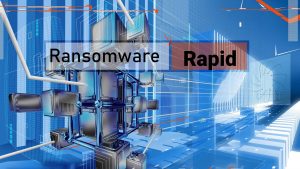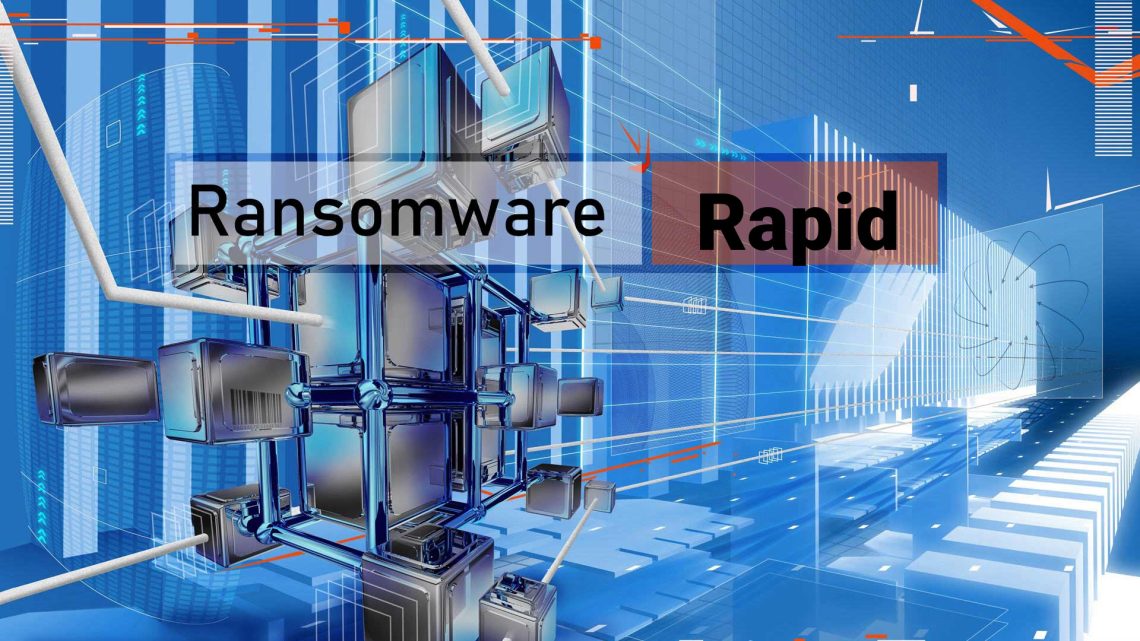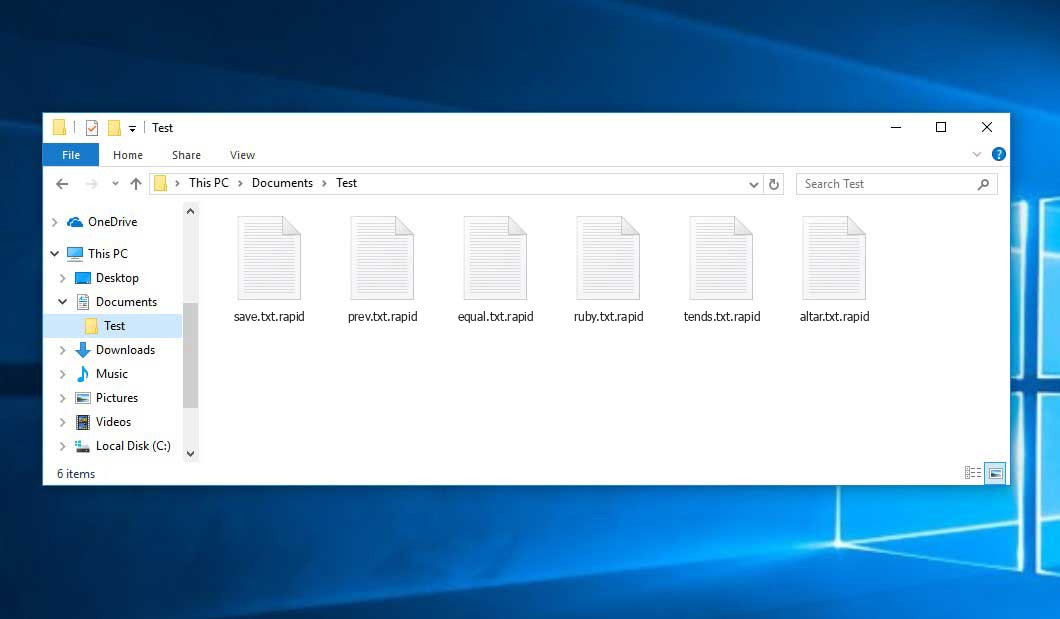The Rapid virus falls within the ransomware type of malicious agent. Ransomware of this type encrypts all user’s data on the PC (photos, text files, excel sheets, audio files, videos, etc) and adds its own extension to every file, creating the recovery.txt text files in each directory with the encrypted files.
What is known about the Rapidvirus?
☝️ A strictly correct denomination for the Rapid is “a ransomware-type malicious agent”.
Rapid will append its extra .rapid extension to every file’s title. For example, a file entitled “photo.jpg” will be changed to “photo.jpg.rapid”. Just like the Excel file named “table.xlsx” will be changed to “table.xlsx.rapid”, and so forth.
In every directory with the encoded files, a recovery.txt text file will be created. It is a ransom money note. Therein you can find information about the ways of paying the ransom and some other remarks. The ransom note usually contains instructions on how to buy the decryption tool from the racketeers. That is how they do it.
Rapid overview:
| Name | Rapid Virus |
| Extension | .rapid |
| Ransomware note | recovery.txt |
| Ransom | $500-$1500 |
| Detection | Trojan.Ransom.VirLock, Ransom:MSIL/Cryptolocker.EK!MTB, Ransom:Win32/MedusaLocker.B!MTB |
| Symptoms | Your files (photos, videos, documents) have a .rapid extension and you can’t open them. |
| Fix Tool | See If Your System Has Been Affected by Rapid virus |
In the image below, you can see what a directory with files encrypted by the Rapid looks like. Each filename has the “.rapid” extension appended to it.
How did Rapid ransomware end up on my PC?
There are plenty of possible ways of ransomware infiltration.
Nowadays, there are three most popular ways for evil-doers to have the Rapid virus working in your system. These are email spam, Trojan infiltration and peer file transfer.
If you access your inbox and see letters that look like familiar notifications from utility services companies, delivery agencies like FedEx, web-access providers, and whatnot, but whose mailer is strange to you, be wary of opening those letters. They are very likely to have a harmful item enclosed in them. Therefore, it is even more dangerous to download any attachments that come with emails like these.
Another thing the hackers might try is a Trojan virus model1. A Trojan is a program that infiltrates into your PC disguised as something different. For instance, you download an installer for some program you need or an update for some service. But what is unboxed turns out to be a harmful program that encrypts your data. As the update wizard can have any title and any icon, you have to make sure that you can trust the resource of the stuff you’re downloading. The best way is to trust the software developers’ official websites.
As for the peer-to-peer file transfer protocols like torrents or eMule, the danger is that they are even more trust-based than the rest of the Web. You can never know what you download until you get it. So you’d better be using trustworthy resources. Also, it is a good idea to scan the directory containing the downloaded items with the antivirus as soon as the downloading is finished.
How do I get rid of the Rapid virus?
It is important to note that besides encrypting your files, the Rapid virus will most likely install the Azorult Spyware on your machine to get access to credentials to various accounts (including cryptocurrency wallets). That program can extract your credentials from your browser’s auto-filling data.
Often criminals would unblock several of your files so you know that they indeed have the decryption program. Since Rapid virus is a relatively new ransomware, safety measures engineers have not yet found a method to undo its work. Nevertheless, the anti-ransomware instruments are frequently updated, so the solution may soon arrive.
Sure thing, if the evildoers succeed in encrypting someone’s essential data, the hopeless person will probably comply with their demands. Nevertheless, paying a ransom does not necessarily mean that you’re getting your blocked information back. It is still dangerous. After getting the money, the racketeers may deliver a wrong decryption code to the victim. There were reports about hackers just disappearing after getting the money without even bothering to reply.
The optimal safety measure against ransomware is to have aan OS restore point or the copies of your critical files in the cloud drive or at least on an external drive. Surely, that might be insufficient. Your most important thing could be that one you were working upon when it all happened. Nevertheless, it is something. It is also wise to scan your PC for viruses with the antivirus program after the system is rolled back.
There are other ransomware products, besides Rapid, that work similarly. Examples of those are Tury, Nuis, Adlg, and some others. The two main differences between them and the Rapid are the ransom amount and the encoding method. The rest is the same: files become encrypted, their extensions changed, ransom notes emerge in each folder containing encoded files.
Some fortunate users were able to decrypt the blocked files with the aid of the free software provided by anti-ransomware experts. Sometimes the criminals mistakenly send the decryption code to the wronged in the ransom note. Such an epic fail allows the victim to restore the files. But naturally, one should never rely on such a chance. Remember, ransomware is a tamperers’ technology to pull the money out of their victims.
How to avoid ransomware infiltration?
Rapid ransomware has no superpower, so as any similar malware.
You can armour yourself from ransomware injection in several easy steps:
- Ignore any letters from unknown senders with strange addresses, or with content that has likely no connection to something you are waiting for (how can you win in a lottery without participating in it?). In case the email subject is more or less something you are waiting for, check all elements of the dubious email carefully. A hoax letter will always contain a mistake.
- Do not use cracked or untrusted programs. Trojans are often shared as a part of cracked products, possibly under the guise of “patch” which prevents the license check. Understandably, untrusted programs are very hard to tell from trustworthy ones, as trojans may also have the functionality you need. Try to find information about this program on the anti-malware message boards, but the optimal solution is not to use such programs at all.
- And to be sure about the safety of the files you downloaded, check them with GridinSoft Anti-Malware. This software will be a perfect defense for your PC.
Reasons why I would recommend GridinSoft2
There is no better way to recognize, remove and prevent ransomware than to use an anti-malware software from GridinSoft3.
Download Removal Tool.
You can download GridinSoft Anti-Malware by clicking the button below:
Run the setup file.
When setup file has finished downloading, double-click on the setup-antimalware-fix.exe file to install GridinSoft Anti-Malware on your system.

An User Account Control asking you about to allow GridinSoft Anti-Malware to make changes to your device. So, you should click “Yes” to continue with the installation.

Press “Install” button.

Once installed, Anti-Malware will automatically run.

Wait for the Anti-Malware scan to complete.
GridinSoft Anti-Malware will automatically start scanning your PC for Rapid infections and other malicious programs. This process can take a 20-30 minutes, so I suggest you periodically check on the status of the scan process.

Click on “Clean Now”.
When the scan has completed, you will see the list of infections that GridinSoft Anti-Malware has detected. To remove them click on the “Clean Now” button in right corner.

Frequently Asked Questions
🤔 How can I open “.rapid” files?Can I somehow access “.rapid” files?
Unfortunately, no. You need to decipher the “.rapid” files first. Then you will be able to open them.
🤔 The encrypted files are very important to me. How can I decrypt them quickly?
If the “.rapid” files contain some really important information, then you probably have them backed up. In case you haven’t, there is still a chance that you do have a Restore Point from some time ago to roll back the whole system to the moment when it had no virus yet, but already had your files. The rest of the methods require patience.
🤔 If GridinSoft deletes the Rapid malware, will it also delete my files that were encrypted?
Absolutely not! Unlike the ransomware program itself, the encrypted files do not jeopardize your system.
GridinSoft Anti-Malware will delete the viruses from your system. The virus that has infiltrated your computer is probably still functional and it scans your system every so often to encrypt any new files you might create on your computer after the initial attack. As it has been said above, the Rapid virus does not come alone. It installs backdoors and keyloggers that can steal your account credentials and provide hackers with easy access to your computer in the future.
🤔 What actions should I take if the Rapid ransomware has blocked my PC and I can’t get the activation code.
In such a case, you need to prepare a flash memory card with a pre-installed Trojan Killer. Use Safe Mode to do the cleaning. The point is that the ransomware runs automatically as the system launches and encrypts any new files created or brought into your machine. To stop this process – use Safe Mode, which allows only the essential programs to run upon system boot. Consider reading our manual on running Windows in Safe Mode.
🤔 What can I do right now?
Some of the blocked data can be located elsewhere.
- If you exchanged your important files by email, you could still download them from your online mailbox.
- You might have shared images or videos with your friends or family members. Simply ask them to give those pictures back to you.
- If you have initially downloaded any of your files from the Internet, you can try doing it again.
- Your messengers, social media pages, and cloud disks might have all those files as well.
- It might be that you still have the needed files on your old computer, a laptop, mobile, external storage, etc.
USEFUL TIP: You can employ file recovery programs4 to get your lost data back since ransomware encrypts the copies of your files, removing the authentic ones. In the video below, you can see how to use PhotoRec for such a recovery, but remember: you can do it only after you remove the ransomware itself with an antivirus program.
Also, you can contact the following governmental fraud and scam sites to report this attack:
- In the United States: On Guard Online;
- In Canada: Canadian Anti-Fraud Centre;
- In the United Kingdom: Action Fraud;
- In Australia: SCAMwatch;
- In New Zealand: Consumer Affairs Scams;
- In France: Agence nationale de la sécurité des systèmes d’information;
- In Germany: Bundesamt für Sicherheit in der Informationstechnik;
- In Ireland: An Garda Síochána;
To report the attack, you can contact local executive boards. For instance, if you live in USA, you can have a talk with FBI Local field office, IC3 or Secret Service.
I need your help to share this article.
It is your turn to help other people. I have written this article to help people like you. You can use the buttons below to share this on your favorite social media Facebook, Twitter, or Reddit.
Brendan SmithHow to Remove RAPID Ransomware & Recover PC

Name: RAPID Virus
Description: RAPID Virus is a ransomware-type infections. This virus encrypts important personal files (video, photos, documents). The encrypted files can be tracked by a specific .rapid extension. So, you can't use them at all.
Operating System: Windows
Application Category: Virus
User Review
( votes)References
- You can read more on Trojans, their use and types in the Trojan-dedicated section of GridinSoft official website.
- GridinSoft Anti-Malware Review from HowToFix site: https://howtofix.guide/gridinsoft-anti-malware/
- More information about GridinSoft products: https://gridinsoft.com/comparison
- Here are Best Data Recovery Software Of 2023.



